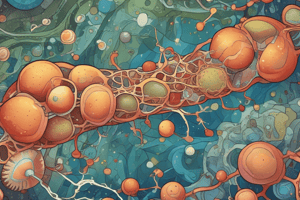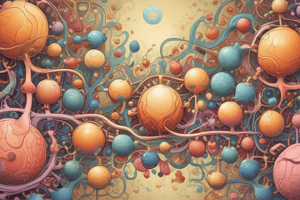Podcast
Questions and Answers
What is the role of bile salts in lipid digestion?
What is the role of bile salts in lipid digestion?
- They convert lipids into water-soluble forms immediately.
- They hydrolyze triglycerides into fatty acids.
- They emulsify lipids to enhance enzyme access. (correct)
- They absorb lipids directly into the bloodstream.
What is formed during the emulsification of triglycerides by bile salts?
What is formed during the emulsification of triglycerides by bile salts?
- Large lipid droplets suspended in water.
- Fatty acids and cholesterol only.
- Mixed micelles including lipids and bile salts. (correct)
- Glycerol and water-soluble fatty acids.
What happens to bile salts during the absorption of lipids?
What happens to bile salts during the absorption of lipids?
- They are absorbed along with fatty acids.
- They remain in the intestinal mucosa.
- They are converted into fatty acids and glycerol.
- They dissociate from micelles and stay in the lumen. (correct)
What results from a blockage in the biliary duct?
What results from a blockage in the biliary duct?
Which component is NOT typically found in a mixed micelle during lipid absorption?
Which component is NOT typically found in a mixed micelle during lipid absorption?
What is a primary role of fatty acids and their derivatives in biological systems?
What is a primary role of fatty acids and their derivatives in biological systems?
Which class of lipids is characterized by the presence of glycerol and fatty acids?
Which class of lipids is characterized by the presence of glycerol and fatty acids?
Why are lipids effective insulators in biological systems?
Why are lipids effective insulators in biological systems?
What is the classification basis for lipids compared to other biomolecules?
What is the classification basis for lipids compared to other biomolecules?
Which of the following is a common use of lipids in humans?
Which of the following is a common use of lipids in humans?
Which group of lipids acts as signaling molecules?
Which group of lipids acts as signaling molecules?
What is a characteristic of triglycerides compared to glycogen?
What is a characteristic of triglycerides compared to glycogen?
Which of the following vitamins is fat-soluble?
Which of the following vitamins is fat-soluble?
What is the total ATP yield from the complete oxidation of one molecule of Palmitoyl-CoA?
What is the total ATP yield from the complete oxidation of one molecule of Palmitoyl-CoA?
How many ATP are generated per carbon atom oxidized from Palmitic acid?
How many ATP are generated per carbon atom oxidized from Palmitic acid?
What is the first step in the oxidation of odd-numbered fatty acids?
What is the first step in the oxidation of odd-numbered fatty acids?
What compound must be further catabolized after oxidation to enter the citric acid cycle?
What compound must be further catabolized after oxidation to enter the citric acid cycle?
Which enzyme is involved in the final oxidation of propionyl-CoA?
Which enzyme is involved in the final oxidation of propionyl-CoA?
What happens when there is a defect in mutase activity concerning propionyl-CoA metabolism?
What happens when there is a defect in mutase activity concerning propionyl-CoA metabolism?
What is the significance of reduced flavoproteins (FAD) in ATP generation during fatty acid oxidation?
What is the significance of reduced flavoproteins (FAD) in ATP generation during fatty acid oxidation?
What is the primary reason for the higher energy yield from fatty acid oxidation compared to carbohydrate oxidation?
What is the primary reason for the higher energy yield from fatty acid oxidation compared to carbohydrate oxidation?
What percentage of dietary fat is constituted by triacylglycerides?
What percentage of dietary fat is constituted by triacylglycerides?
Which of the following lipids are soluble in organic solvents?
Which of the following lipids are soluble in organic solvents?
How do bile salts facilitate lipid digestion?
How do bile salts facilitate lipid digestion?
What is the role of the carboxyl group in bile acids?
What is the role of the carboxyl group in bile acids?
Which enzymes are involved in the digestion of emulsified lipids?
Which enzymes are involved in the digestion of emulsified lipids?
What is a primary source of triacylglycerols for the body?
What is a primary source of triacylglycerols for the body?
What structural feature gives bile salts their emulsifying properties?
What structural feature gives bile salts their emulsifying properties?
What is the significance of micelles formed by bile salts?
What is the significance of micelles formed by bile salts?
What is the primary site of triacylglycerol digestion?
What is the primary site of triacylglycerol digestion?
What enzyme is primarily responsible for hydrolysing triacylglycerol?
What enzyme is primarily responsible for hydrolysing triacylglycerol?
Which component forms mixed micelles along with monoacylglycerols and fatty acids?
Which component forms mixed micelles along with monoacylglycerols and fatty acids?
What would likely occur in patients with an abnormally low concentration of bile salts?
What would likely occur in patients with an abnormally low concentration of bile salts?
What is a common cause of reduced bile salt concentration in the intestine?
What is a common cause of reduced bile salt concentration in the intestine?
What happens to fatty acids after absorption into intestinal epithelial cells?
What happens to fatty acids after absorption into intestinal epithelial cells?
Which vitamins are notably at risk of deficiency in patients with low bile salt concentrations?
Which vitamins are notably at risk of deficiency in patients with low bile salt concentrations?
What is the purpose of bile salt micelles in the digestion process?
What is the purpose of bile salt micelles in the digestion process?
Flashcards are hidden until you start studying
Study Notes
Fatty Acid Oxidation
- Palmitoyl-CoA (16 carbon fatty acid) degrades to 8 mol of acetyl-CoA.
- Balanced equation for oxidation:
- Palmitoyl-CoA + 7CoA-SH + 7FAD + 7NAD+ + 7H2O → 8 acetyl-CoA + 7FADH2 + 7NADH + H+.
- Each FADH2 produces 2 ATP and each NADH produces 3 ATP, totaling 35 ATP from reduced cofactors.
- Oxidation of 8 acetyl-CoA through the TCA cycle yields 96 ATP.
- Net ATP yield from one palmitic acid: 130 ATP (35 + 96 - 1 for activation).
- ATP yield per carbon oxidized: approximately 8.1 (130/16).
- For comparison, glucose yields 6 ATP per 6 carbons oxidized.
Odd-Numbered Fatty Acid Oxidation
- Odd-numbered fatty acids are oxidized similarly to even-numbered, starting at the carboxyl end.
- Final cycle features a 5-carbon acyl-CoA (Butyryl-CoA).
- Cleavage yields acetyl-CoA (2C) and propionyl-CoA (3C).
- Acetyl-CoA is fully oxidized; propionyl-CoA requires further catabolism.
- Increased methylmalonyl-CoA due to defective mutase or vitamin B12 deficiency leads to severe acidosis.
Lipids Overview
- Organic molecules, soluble in non-polar solvents, sparingly soluble in water.
- Serve protective roles (moisture retention in birds, humans, camels).
- Provide energy in diets through sources like oils and margarine.
Lipid Classes
- Classified based on solubility:
- Fatty acids (saturated, unsaturated, eicosanoids).
- Esters of fatty acids and glycerol (triglycerides, phosphoglycerides).
- Lipids without glycerols (sphingolipids).
- Sterols (cholesterol, steroid hormones, vitamin D).
- Terpene and isoprenoid derivatives.
Functions of Lipids
- Serve as high-energy storage, yielding 6 times more energy than glycogen.
- Provide insulation and reduced heat exchange via adipose tissue.
- Form hydrophobic barriers in cellular membranes.
- Act as signaling molecules (prostaglandins, steroids) and enzyme cofactors.
- Precursors to fat-soluble vitamins (A, D, E, K).
Lipid Digestion and Absorption
- 90% of dietary lipids are triglycerides (TAGs).
- Digestion begins in the stomach but is limited due to aggregation.
- Bile salts (detergent action) emulsify TAGs, aiding fat digestion.
Role of Bile Salts
- Bile salts possess both hydrophobic and hydrophilic surfaces, allowing for emulsification at the oil-water interface.
- Form micelles, facilitating digestion by water-soluble pancreatic lipases and absorption into intestinal mucosa.
Lipase Action
- Lipases hydrolyze ester linkages in TAGs, producing monoacylglycerol and fatty acids.
- Stable interaction with water is necessary for absorption.
Clinical Implications
- Conditions such as biliary duct obstruction lead to steatorrhea (bulky, oily stools).
- Inadequate bile salts affect absorption of fat-soluble vitamins, potentially leading to deficiencies.
- Patients may require dietary modifications and vitamin supplementation through injection.
Post-Absorption
- Inside intestinal epithelial cells, fatty acids are re-esterified into triglycerides after absorption.
Studying That Suits You
Use AI to generate personalized quizzes and flashcards to suit your learning preferences.




